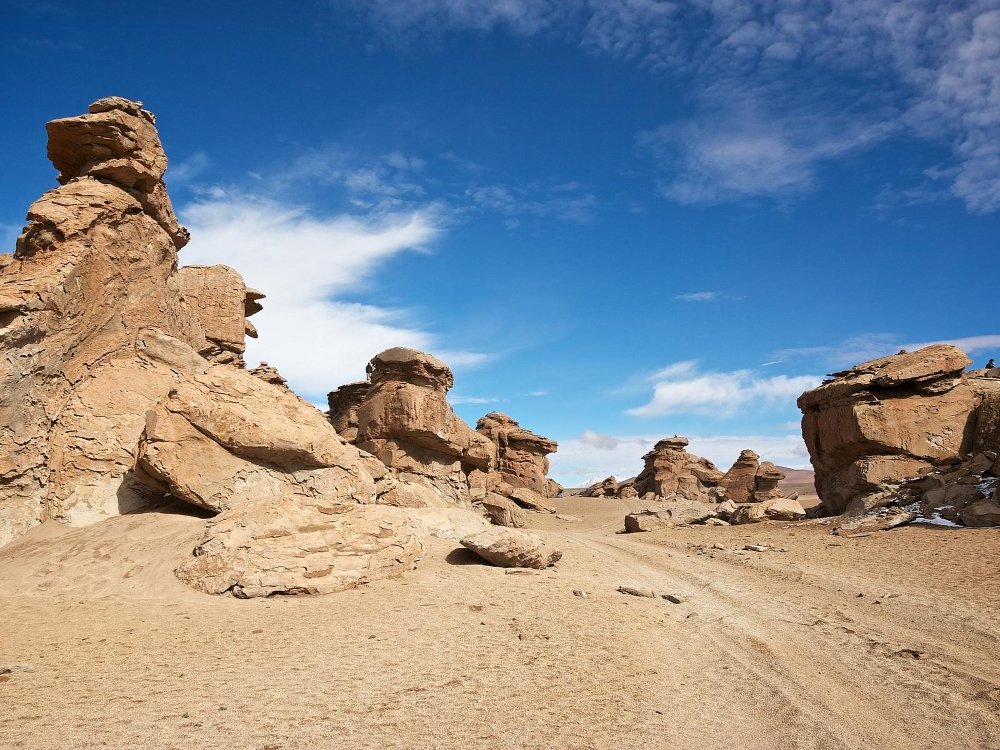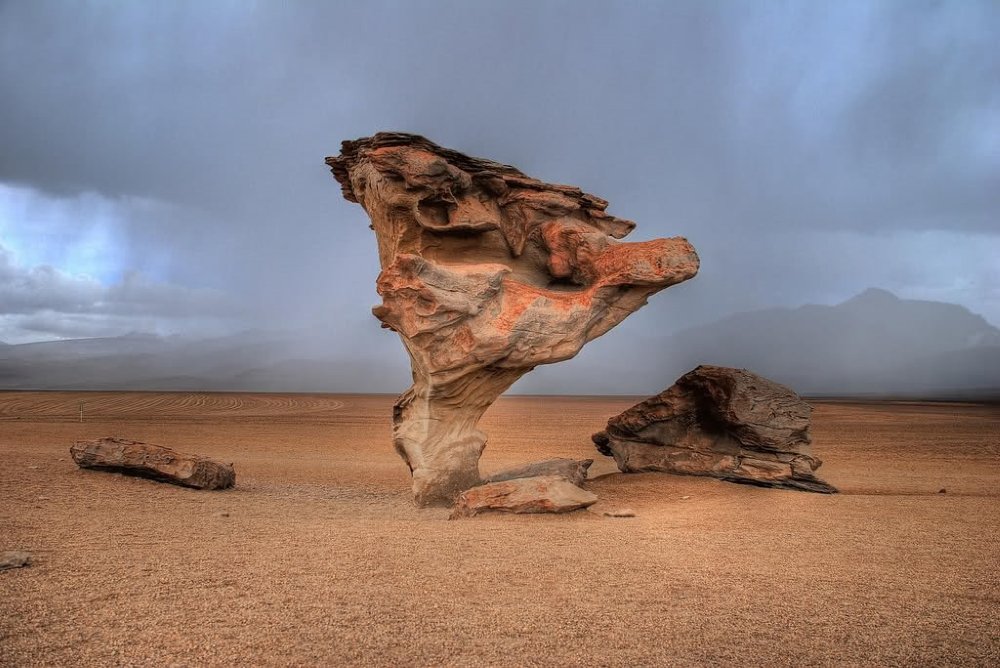Siloli Desert | Bolivia
The Siloli Desert is located in southwestern Bolivia, specifically in the Andean Altiplano region, near the border with Chile. It is part of the Eduardo Avaroa National Andean Fauna Reserve, a protected area known for its unique and varied landscape, which includes altiplanic lagoons, geysers, volcanoes and desert landscapes.
The Siloli Desert is famous for its naturally eroded rock formations, which include bizarre and whimsically shaped rocks and outcrops. One of the most iconic landmarks in this desert is the famous “Tree Rock”, a rock formation that resembles a tree and is one of the most photographed points of interest in the area.
“Siloli” is a word that comes from the Aymara language, which is spoken by some indigenous communities in Bolivia, Peru and parts of Chile and Argentina. However, there is actually no exact translation of “Siloli” into Spanish, as it is a proper name of indigenous origin that has been used to name various geographic locations and natural features in the Andean region.
In the specific case of the Siloli Desert in Bolivia, the name appears to be a geographic reference or a name given by local communities to describe that particular area of the Andean highlands. It is important to keep in mind that place names in indigenous languages often have specific cultural or historical meanings for the communities that use them, and may not have a direct translation into Spanish or other languages.
History of the Siloli Desert | Bolivia
The Siloli Desert is a desert region located in the Bolivian altiplano, near the border with Chile, in the Potosí region. Although there is no specific history of the desert itself, its formation and importance are framed in the geological and historical context of the Andean region.
- Geological Formation: The formation of the Siloli Desert is related to the geology of the Andean region, which has been shaped by tectonic and volcanic activity over millions of years. Wind and fluvial erosion have contributed to the creation of unique desert landscapes, such as the one found in Siloli.
- Indigenous Culture and Tradition: The Andean region has been inhabited by diverse indigenous cultures throughout history, including Aymara and Quechua communities. These cultures have had a deep connection to the land and have left their mark on the landscape and history of the region.
- Tourism and Conservation: In recent decades, the Siloli Desert has gained popularity as a tourist destination due to its unique and attractive landscape. It is located within the Eduardo Avaroa National Andean Fauna Reserve, an important protected area that conserves the biodiversity of the Andean region and its unique ecosystems.
- Tourist Routes: The Siloli Desert is part of several popular tourist routes in the region, which include the Uyuni Salt Flat, altiplanic lagoons and other places of interest. Tour operators offer excursions that allow visitors to explore and enjoy the natural beauty and uniqueness of the desert.
In summary, although the Siloli Desert itself has no specific history, its importance lies in its unique geological formation, its connection to the indigenous cultures of the region and its role as a tourist destination in the Bolivian altiplano.

What to see in the Siloli Desert?
The Siloli Desert, located in the Bolivian highlands, offers a number of breathtaking landscapes and sights for visitors. Here are some things to see and do in the Siloli Desert:
- Tree Rock
One of the highlights of the Siloli Desert is the famous Tree Rock, a natural rock formation that resembles a tree. It is a popular place to take photographs due to its uniqueness and location in the middle of the desert.
- Geological Formations
The desert is full of interesting geological formations, including eroded rocks and outcroppings that create unique and whimsical landscapes. Exploring these rock formations is a fascinating experience and offers opportunities for photography.
-
Desert Landscapes
The Siloli Desert offers extensive views of desert landscapes, with vast expanses of arid land and distant mountains. The contrasting colors and geological formations make the landscape visually stunning.
- Wildlife
Despite its desolate appearance, the desert is home to a variety of wildlife adapted to the harsh conditions of the highlands. Visitors may have the opportunity to spot unique birds, mammals and reptiles in their natural habitat.
- Cultural Experience
In addition to nature, the Siloli Desert also offers an opportunity to experience the local culture and learn about the indigenous communities that have inhabited the region for centuries. Some tours offer the possibility to interact with the local communities and learn about their traditions and lifestyle.
- Night Sky Observation
Due to its remote location and lack of light pollution, the Siloli Desert is an ideal place for night sky observation. On a clear night, visitors can enjoy a breathtaking show of stars and constellations.
These are just some of the things you can see and experience in the Siloli Desert. Each visit offers a unique opportunity to explore and appreciate the beauty and diversity of this desert landscape in the Bolivian highlands.
How to get to the Siloli Desert?
To get to the Siloli Desert in Bolivia, you can follow these steps:
- Getting to Uyuni: Most travelers start their trip to Siloli from the city of Uyuni, which is the main starting point for exploring the Bolivian altiplano and the Salar de Uyuni. You can reach Uyuni by bus from nearby cities such as La Paz or Potosi, or by plane to Uyuni’s Joya Andina Airport.
- Organize a Tour: The most common way to visit the Siloli Desert is through an organized tour. In Uyuni, you will find numerous tour agencies offering excursions to the Salar de Uyuni and its surrounding attractions, which often include a visit to the Siloli Desert.
- Booking a Siloli Desert Tour: Once in Uyuni, you can search for and book a tour that includes a visit to the Siloli Desert. These tours are usually one or several days and can vary in price and amenities. It is important to choose a reliable tour agency with good reviews.
- Siloli Desert Tour: Once you have booked your tour, the tour operator will pick you up at your accommodation in Uyuni or at a designated meeting point. The tour will take you to the Siloli Desert, where you will have time to explore and enjoy the unique views and landscapes.

Recommendations for a visit to the Silioli Desert
For a visit to the Siloli Desert in Bolivia, here are some recommendations:
- Altitude Preparation
The Siloli Desert is located in the Bolivian altiplano, at a considerable altitude. If you are coming from lower regions, such as La Paz, you may feel the effects of altitude sickness. Get adequate rest and drink plenty of water to stay hydrated. Avoid alcohol and caffeine in excess.
- Adequate Clothing
The weather in the altiplano can be unpredictable, with hot days and cold nights. Wear layered clothing that allows you to adapt to temperature changes. Include warm clothes for the night and windbreakers for the day.
- Sunscreen and Sunglasses
Sun exposure at high altitudes can be intense. Use broad-spectrum sunscreen with a high protection factor and sunglasses to protect your eyes from UV rays.
- Hydration and nutrition
Bring enough water and some snacks to keep you hydrated and energized throughout the day. Be sure to eat nutritious meals to keep your energy up.
-
Appropriate Footwear
The terrain in the desert can be uneven, with rocks and stones. Wear comfortable, sturdy footwear, such as hiking boots or sturdy sneakers, that provide good grip and protection.
- Respect for the Environment
Be sure to follow the rules and regulations of the protected area and respect the natural environment. Do not leave trash and avoid disturbing the local flora and fauna.
- Responsible Photography
If you plan to take photographs, respect the environment and the privacy of other visitors. Avoid stepping on fragile areas and respect any photography restrictions in the area.
- Guided by Professionals
If you opt for a guided tour, choose a company with professional guides with experience in the region. They can provide you with invaluable information about the history, geology and ecology of the area.
By following these recommendations, you will be well prepared to enjoy a memorable experience in the Siloli Desert.












